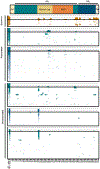A public, cross-reactive glycoprotein epitope confounds Ebola virus serology
- PMID: 39370872
- PMCID: PMC11874798
- DOI: 10.1002/jmv.29946
A public, cross-reactive glycoprotein epitope confounds Ebola virus serology
Abstract
Ebola disease (EBOD) in humans is a severe disease caused by at least four related viruses in the genus Orthoebolavirus, most often by the eponymous Ebola virus. Due to human-to-human transmission and incomplete success in treating cases despite promising therapeutic development, EBOD is a high priority in public health research. Yet despite almost 50 years since EBOD was first described, the sources of these viruses remain undefined and much remains to be understood about the disease epidemiology and virus emergence and spread. One important approach to improve our understanding is detection of antibodies that can reveal past human infections. However, serosurveys routinely describe seroprevalences that imply infection rates much higher than those clinically observed. Proposed hypotheses to explain this difference include existence of common but less pathogenic strains or relatives of these viruses, misidentification of EBOD as something else, and a higher proportion of subclinical infections than currently appreciated. The work presented here maps B-cell epitopes in the spike protein of Ebola virus and describes a single epitope that is cross-reactive with an antigen seemingly unrelated to orthoebolaviruses. Antibodies against this epitope appear to explain most of the unexpected reactivity towards the spike, arguing against common but unidentified infections in the population. Importantly, antibodies of cross-reactive donors from within and outside the known EBOD geographic range bound the same epitope. In light of this finding, it is plausible that epitope mapping enables broadly applicable specificity improvements in the field of serology.
Keywords: Ebola virus; epitope mapping; false positive reactions; glycoprotein; immunodominant site; serologic tests.
Published 2024. This article is a U.S. Government work and is in the public domain in the USA. Journal of Medical Virology published by Wiley Periodicals LLC.
Conflict of interest statement
CONFLICT OF INTEREST STATEMENT
The authors declare no conflict of interest.
Figures






References
-
- European Medicines Agency. EMA/CHMP/557387/2019 Summary of Opinion (Initial Authorisation) Ervebo Ebola Zaire Vaccine (rVSVΔG-ZEBOV-GP, live). 2019.
-
- U.S. Food & Drug Administration. BLA Approval BL 125690/0 (Ebola Zaire Vaccine, Live). 2019.
-
- European Medicines Agency. EMA/CHMP/138136/2020 Summary of Opinion (Initial Authorisation) Mvabea Ebola vaccine (MVA-BN-Filo [recombinant]). 2020.
MeSH terms
Substances
Grants and funding
LinkOut - more resources
Full Text Sources
Medical
Miscellaneous

